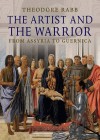The Artist and the Warrior: Military History through the Eyes of the Masters
Written by: Theodore K. Raab,
Yale University Press, 2011,
ISBN: 9780300126372, 228 pp
Reviewed by: Dr Claire Baddeley, Senior Curator of Art, Australian War Memorial
The preoccupation with war and its representation has long been the subject matter of artists. Whether recording battles or the heroism and suffering of war’s protagonists, artists have depicted conflict in its many forms over the centuries. From early images in Egyptian and Roman art through to contemporary works of art, military history has proven fertile ground for creative responses to war. Theodore K. Rabb’s The Artist and the Warrior: Military History through the Eyes of the Masters is a book that articulately blends the worlds of war and art into a highly readable and engaging book.
In each of his chapters, Rabb moves chronologically through the wide terrain of European art, selecting masterpieces by well-known artists and sculptors such as Donatello, Uccello, Titian, Velázquez, Rubens, Goya, Manet and Picasso. His choice of works of art in this richly illustrated publication allows close analysis of the way in which artists have responded to war. They reveal something of the art-historical, conceptual and aesthetic contexts in which they were created as well as the history of events, battles, individuals and warfare over time.
The discussion of individual artworks is successfully interwoven with a detailed narrative of the history of military practices including technological developments and inventions from gunpowder to poisonous gases. While the works of art selected are from the Western tradition, the focus shifts on a number of occasions to war art from Japan, India and the Middle East. Although this detour complements the masterpieces chosen, their inclusion appears tokenistic and fragments the discussion of the ambitious array of visual reactions to warfare. This leaves the reader yearning to dip into the comparative history of war art in non-Western traditions, a topic that is beyond the scope of this publication.
The book ranges widely, from antiquity to the last century. It begins with the ancient world, focusing on the Stones of Nineveh. From here the course is charted through Rome and the Middle Ages, the Renaissance, and the sixteenth to the nineteenth centuries, before it concludes with a chapter entitled ‘The Pity of War: Modern Times’. The military and technological transformations from gunpowder in the fourteenth century to industrialised warfare in the last century foreground each chapter. This provides a lucid military historical context against which individual paintings, sculptures, works on paper, photographs, monuments and finally film are analysed. Throughout the book shifting attitudes to war through art are broadly examined — from heroism and triumph to suffering and inhumanity.
The book’s breadth is both its strength and its weakness and its multidiscipli- nary nature promises an audience of both military historians and art historians. It will probably appeal most, however, to those who take a more extended view of military history, as it moves beyond details of the manoeuvres of individual battles to the social, cultural and economic context of warfare. Few other studies of war art provide such comprehensive details of the evolving nature of warfare, along with shifting artistic and social perceptions of war itself.
Despite the author’s admission that it is not ‘an enterprise of primary research’, the inclusion of quotes, where possible, from the individual artists whose works feature in this well-researched book would have been beneficial. How did the artists feel about their subject matter? How did they construct scenes of battle which they did not witness themselves? What meanings did they intend to convey through images of the most heroic and tragic aspects of warfare?
The Artist and the Warrior: Military History through the Eyes of the Masters can be criticised for this lack of use of original material and its reliance on secondary sources to analyse the ongoing relationship between art and war. The decision by the author to somewhat abruptly end at the 1930s is also of concern, since it means the military and artistic history of major conflicts such as the Second World War and the Vietnam War are not analysed. Rabb argues that the later twentieth century has produced far fewer divergent responses to war, with little new direction in artistic imagery beyond that which comments on its violence, anguish and tragedy. This is a questionable claim and does not take into account the work of official war artists appointed in Australia, Canada, Great Britain and New Zealand who objec- tively recorded conflicts, works of art by prisoners of war, or the many humorous responses to war through cartoons and caricatures which variously provided relief, critique and entertainment both for those exposed to war and the fortunate others who were not.

